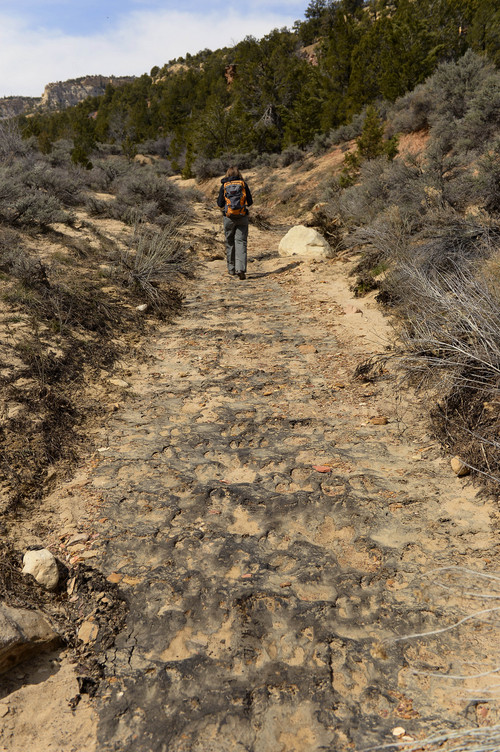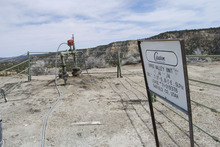This is an archived article that was published on sltrib.com in 2014, and information in the article may be outdated. It is provided only for personal research purposes and may not be reprinted.
The oil coating a desert wash outside Escalante came from three distinct spills over four decades, according to a report released Tuesday by the Bureau of Land Management. Because the hundreds of barrels of oil appear to be degrading in place and are no longer shedding chemical residues downstream, the agency has no immediate plans to clean it up.
"It doesn't represent a threat to the watershed or wildlife at this point, but the report does recommend continual monitoring," said Larry Crutchfield, spokesman for Grand Staircase-Escalante National Monument.
Nor do federal officials plan to punish the well's current operator, Citation Oil and Gas Corp., which may not have owned the Upper Valley oil field during the two older, major spills into Little Valley and four other washes leading into what became a national monument.
But the company, which was responsible for a small, unreported recent spill, will be required to prepare a new surface use plan and consult quarterly with the BLM and Dixie National Forest, which manages the western half of the oil field.
"We recognize the age of the field and the potential for future infrastructure failures. We will be working with Citation to conduct a thorough assessment of the Upper Valley oil field infrastructure — including pipelines and monitoring equipment — that could fail and lead to another spill event," said the BLM's Utah state director, Juan Palma, in a statement.
Two local residents discovered the recent spill on March 22 while scouting Little Valley for a hunt. A BLM investigation quickly identified Citation's Well No. 27 as the likely source of the oil.
But officials were baffled by what appeared to be a mix of fresh crude staining rocks and trees and older material more similar to asphalt covering the wash bed up to six inches deep.
The well, which was drilled in 1971, is now producing only 15 to 17 barrels of oil a day, along with about 400 barrels of water. After the hikers reported the oil find, Citation officials acknowledged a flowline serving the well had developed a "pinhole leak" that was discovered within 24 hours last December.
Crews patched the pipe, but Citation did not report the incident to the BLM because the spill did not reach the 10-barrel reporting threshold, according to the report.
"Subsequent field investigations have shown that this leak did flow into Little Valley Wash, probably in concert with melting snow and over both snowpack and ice, and did splatter trees, bushes, and other vegetation before reaching the drainage floor and following the path of an earlier leak from the pipeline," the report states.
Monument officials have since tightened the reporting requirement.
"If it leaks a glassful and they know it they need to report it within 24 hours," Crutchfield said.
Chemical analysis of the oil in Little Valley, along with other evidence, suggests that much of the crude is up to 40 years old. BLM officials interviewed several Escalante residents who recalled that spills associated with the Upper Valley field were not uncommon in those days, back when it was in its production prime and environmental standards were lax.
The unit's 18 producing and nine injection wells were drilled between 1962 and 1986 and have yielded more than 28 million barrels of oil.
Among those interviewed was current Escalante Mayor Jerry Taylor, who spent summers in the early 1970s working construction crews.
"He worked spreading dirt and burning pits, the then BLM-standard treatment for oil spills. Although he did not recall exactly which of the drainages leading from the field he worked in, he believed that he might have been involved in clean up of several of the drainages," the report states
Officials believe the first spill in Little Valley occurred from the well itself when it was drilled in 1971 and again from a pipe rupture in the 1980s, although neither the BLM nor the U.S. Forest Service have any record of such spills.
Today this oil has already shed most of its lighter hydrocarbon and no longer poses much of a threat to natural resources, according to an analysis commissioned by the oil company.
"We could do more harm at this stage by going in with heavy equipment to try removing it," Crutchfield said.
The BLM will keep close tabs on Little Valley and neighboring washes, which drain into the Escalante River 50 miles downstream at Harris Wash, to determine whether there has been long-term damage, acting monument manager Cynthia Staszak said.
If monitoring shows hydrocarbons are seeping into the watershed, the agency may reevaluate its passive remediation strategy, she said.







